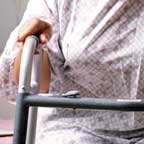
With winter weather upon us, a concern for many is fall prevention. For those of us with aging parents, this may be something we think about a lot. In fact, one of every three Americans aged 65 or older falls each year, according to the Centers for Disease Control & Prevention. While this fact is something most of us have the luxury of ignoring until it hits close to home, the effects of falls and the fear of falls on older adults is very real.
When someone begins to fear a fall, he or she will go out less frequently and reduce his or her normal activities—all of which can lead to reduced independence and increased social isolation. This is a very real fear; falls are the leading cause of injury deaths and the most common cause of nonfatal injuries and hospital admissions for trauma.
It’s important to consider every way in which we can reduce the risk of falls for ourselves or our loved ones. Because one-third of falls are caused by environmental hazards, this is a good place to start. While they may look pretty, throw rugs can be dangerous in walkways. The bathroom also can be a real problem spot, but you can reduce risk by using non-slip mats in the bathtub and on shower floors and having grab bars put in next to the toilet and in the tub or shower. If the living space is more than one level, have handrails put in on both sides of stairways, and be sure that lighting is good throughout the home. Other hazardous issues to keep in mind are slick or wet floors and glare off of windows or other shiny surfaces. A few small changes and heightened awareness can help prevent a big problem.
After removing environmental hazards, there are other steps a person can take to reduce their risk of a fall. Exercise can help improve coordination, balance, and strength, which will help prevent a fall and help those who may have fallen previously. As vision and balance have been blamed for a good number of falls, it’s very important to have your eyes checked. Another factor that can affect one’s balance is drug interaction. Talk with your doctor regularly and be sure you’re aware of the side effects of all of your medications. For more information on fall prevention, talk with your doctor and visit www.cdc.gov/injury. TPW
